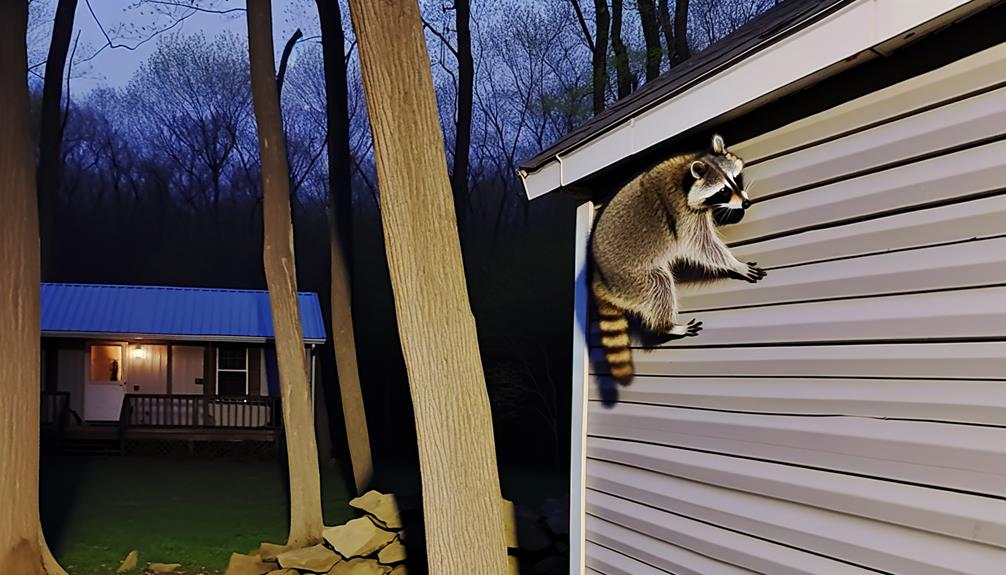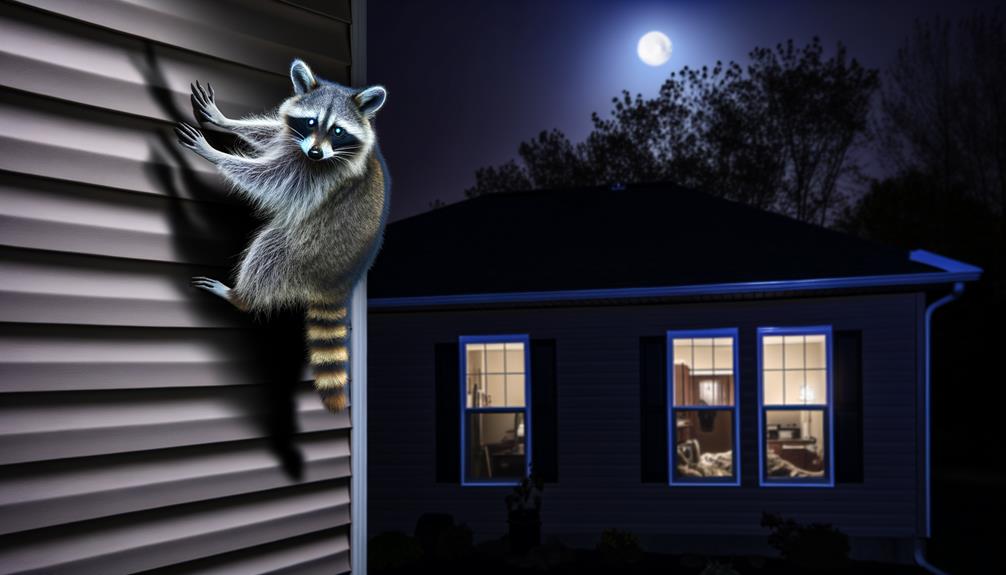How to Prevent Raccoons from Climbing Vinyl Siding
Raccoons have strong, dexterous forelimbs and sharp claws, enabling them to climb a variety of surfaces, including vinyl siding. Despite the smooth, low-friction nature of vinyl siding, raccoons' flexible joints, robust musculature, and non-retractable claws help them grip and ascend.
Their long tails assist with balance during such endeavors. Urban encounters affirm their adaptability to exploit weaknesses in residential structures.
Consequently, vinyl siding does not completely prevent raccoons from climbing and potentially causing damage. Understanding raccoon behavior and taking preventative measures is essential for homeowners aiming to protect their properties from these adept climbers.

Key Takeaways
- Raccoons possess strong forelimbs and claws for climbing various surfaces, including vinyl siding.
- Despite vinyl siding's smooth texture, raccoons' dexterous toes provide sufficient traction.
- Raccoons use their flexible joints and musculature to maneuver and grip vinyl siding effectively.
- Their bushy tails aid in balance, enhancing their climbing ability on vertical surfaces.
- Preventative measures like sealing entry points can mitigate raccoon intrusion via vinyl siding.
Raccoon Climbing Abilities

Raccoons possess remarkable climbing abilities due to their strong, dexterous forelimbs and sharp claws, which enable them to scale various surfaces with ease. These anatomical adaptations are complemented by their flexible joints and robust musculature, allowing for significant grip and maneuverability.
The forelimbs are equipped with five toes, each ending in a non-retractable claw, providing traction on diverse substrates. Additionally, raccoons have a highly developed sense of balance, facilitated by their long, bushy tails, which act as counterweights during ascension.
Their climbing prowess is not limited to natural environments; raccoons can adeptly navigate human-made structures, such as fences and trees, exhibiting a high degree of problem-solving and persistence. This combination of physical and cognitive traits underpins their exceptional climbing capabilities.
Characteristics of Vinyl Siding
Vinyl siding, a popular choice for exterior cladding, is composed of polyvinyl chloride (PVC) resin, which provides durability, weather resistance, and minimal maintenance requirements. This material exhibits high tensile strength, making it resistant to impact and deformation.
Its surface is typically smooth, which contributes to its low friction coefficient, thereby potentially affecting the ability of certain animals to climb it. The molecular structure of PVC ensures that it is impervious to water and resistant to UV radiation, thereby preventing degradation over time.
Additionally, vinyl siding is available in a variety of styles and colors, offering aesthetic flexibility. Its thermal properties also contribute to energy efficiency by providing a degree of insulation.
Real-life Raccoon Encounters

Urban raccoon sightings have become increasingly common, with numerous reports documenting their adaptability to city environments.
Home intrusion stories further illustrate their ability to exploit weaknesses in residential structures, including vinyl siding.
These real-life encounters provide valuable data for understanding raccoon behavior and their interactions with human habitats.
Urban Raccoon Sightings
In recent years, numerous documented cases have emerged detailing raccoon sightings in urban environments, providing valuable insights into their adaptive behaviors and interaction with human habitats. These nocturnal mammals have increasingly been observed maneuvering through city landscapes, utilizing urban infrastructure such as rooftops, chimneys, and even public transportation systems.
Analysis of various sightings indicates raccoons exhibit remarkable problem-solving abilities and dexterity, often scavenging for food in trash bins and exploiting structural features of buildings. Their capacity to thrive in densely populated areas underscores their ecological versatility and raises questions about the impact of urbanization on wildlife behavior.
This phenomenon necessitates further research to understand the long-term implications for both raccoon populations and urban ecosystem dynamics.
Home Intrusion Stories
Among the myriad documented interactions between humans and raccoons, real-life home intrusion stories provide a compelling window into the adaptability and resourcefulness of these nocturnal creatures. Their ability to exploit structural vulnerabilities in homes is well-documented, often leading to surprising and sometimes destructive encounters. For instance, raccoons are known to enter through attics, chimneys, and even pet doors. These encounters highlight their dexterity and persistence in seeking shelter and food within human habitats.
| Incident Type | Entry Point | Outcome |
|---|---|---|
| Attic Intrusion | Roof Vents | Structural Damage |
| Chimney Entry | Chimney Flue | Soot and Debris Spread |
| Pet Door Access | Pet Door | Pet Food Consumption |
Such incidents underscore the need for robust preventive measures to mitigate these uninvited visits.
Potential Risks to Homeowners
Given their dexterous nature and climbing proficiency, raccoons pose several potential risks to homeowners, especially when it comes to property damage and health hazards. Structurally, raccoons can damage roofing, insulation, and siding in their attempts to access attics or crawl spaces. Their foraging behavior often results in overturned trash bins and scattered waste, further attracting pests.
Additionally, raccoons are vectors for numerous pathogens, including rabies, leptospirosis, and roundworms, which can be transmitted to humans and pets. Their feces, often found in attics and other secluded areas, can harbor dangerous parasites.
The combination of physical damage and health risks underscores the necessity for homeowners to remain vigilant and informed about the presence and behavior of raccoons near their properties.
Preventative Measures

Implementing effective preventative measures is essential to safeguarding homes from the structural and health hazards posed by raccoons. Key strategies include securing garbage bins with raccoon-proof lids and storing them indoors when possible.
Ensuring that all entry points, such as chimneys, vents, and gaps in the roofline, are sealed with durable materials like steel mesh can prevent raccoon access. Additionally, trimming tree branches that overhang the house reduces their ability to reach the roof.
Employing motion-activated lights or sprinklers can deter raccoons from approaching the home. Regularly inspecting and maintaining the integrity of vinyl siding and other exterior features further mitigates the risk of raccoon intrusion. These measures collectively contribute to a raccoon-resistant environment.
Additional Home Safeguards
Enhancing home security against raccoon infiltration necessitates the integration of advanced structural reinforcements and vigilant monitoring systems. One effective measure involves installing raccoon-proof chimney caps and reinforced vent covers to prevent access through potential entry points.
Additionally, utilizing motion-activated lights and cameras can deter nocturnal activity, providing real-time alerts and visual deterrence. Sealing gaps in roofing, soffits, and fascia with durable materials such as sheet metal or heavy-duty mesh further obstructs entry. Regularly inspecting and maintaining these installations is vital to guarantee their effectiveness.
Conclusion
To sum up, the intricate ballet of raccoons scaling vinyl siding reveals both the remarkable adaptability of these nocturnal acrobats and the vulnerabilities of modern housing materials. Homeowners, ever vigilant, must arm themselves with preventative measures and additional safeguards to thwart these uninvited climbers.
After all, in the grand battle between human ingenuity and raccoon tenacity, it would be a travesty to let such cunning critters outwit the supposed apex species of the planet.






